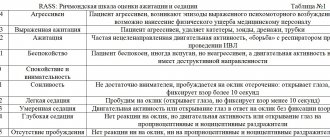Cognitive processes in the system of mental phenomena
Perception is the simplest mental process, which consists in reflecting certain properties of objects and phenomena of the material world, as well as the internal states of the body under the direct influence of stimuli on the corresponding receptors.
Not all existing types of energy, even if they are vital, are perceived by humans in the form of sensations. For some of them, for example, the radiation is not felt mentally at all. Thus, a person receives in the form of sensations a small but very significant part of the information and energy acting on his body.
Lack of sensation leads to serious disruptions in the functioning of the body.
The following types of sensations are distinguished:
1) Upon contact with a stimulus:
- Far.
- Contact
- auditory
- visual
- olfactory
- tactile
- tastes
2) depending on the location of the receiver:
(a) interoceptive - signal about the internal state of the body.
b) Proprioceptive - signals the position of body parts and their movement.
c) Exteroceptive - signal various features of the external world (visual, auditory, skin, olfactory).
For sensations to occur, stimulation must reach a certain strength. For example, if we put a sugar crystal in a glass of water, we are unlikely to taste the sweetness. If we add one sugar crystal after another, we will eventually find that the water has become sweet. The minimum size of the stimulus that causes a subtle sensation is called the lower threshold of sensitivity. The lower the threshold, the higher the sensitivity. These thresholds are individual for each person. For example, one person hears very faint sounds (the ticking of a wristwatch), or one person perceives a dim, dim light, while for another the light needs to be a little brighter. In addition, different analyzers have different threshold values. For example, people have a very high sensitivity to smells. Visual and gustatory sensitivity are high, while tactile (skin) sensitivity is relatively low. Subliminal stimuli are called subliminal. The body does not perceive these irritants. This is definitely a protective reaction of the body, because if the body were to constantly receive and process information at all receptors, it would lead to exhaustion. The upper sensitivity threshold is the highest value at which sufficient sensitivity is still maintained [Error: Reference source not found,129]. For example, if we pour salt into water, we end up perceiving a bitter taste rather than a salty taste. In most cases, suprathreshold stimuli cause pain (eg, extremely loud sound, blinding brightness).
Absolute sensitivity is not constant throughout life: children's sensitivity develops and reaches its highest level during adolescence. It decreases with age. The activities a person engages in have a significant impact on sensitivity. For example, tasters are better at distinguishing flavors (experienced wine tasters can tell not only what grapes a wine is made from, but also where it was grown).
Sensations have the following characteristics:
Adaptation is the adaptation of the senses to external influences. For example, when we step out of a dark room into a bright light, we are momentarily blinded, but after a few minutes our eyes adapt and we see normally.
Synesthesia is the occurrence, under the influence of stimulation of one analyzer, of sensations characteristic of another analyzer. For example, a person experiences visual images under the influence of sound stimuli - visual-auditory synesthesia.
Sensitization is an increase in sensitivity as a result of interaction with the analyzer and practice. For example, weak musical tones can increase the sensitivity of the visual analyzer.
Cognitive sphere as a systemic education
Perception is a holistic reflection of objects or phenomena in the human mind with their direct impact on the senses.
Only people and higher animals are endowed with the ability to perceive the world in the form of images; it is formed and improved in their life experiences.
Unlike sensations, perceptual processes form an image of a complete object, reflecting the entire set of its properties. Thus, perception is not reduced to the sum of individual sensations, but represents a qualitatively new stage of sensory perception with its inherent characteristics.
The main characteristics of perception are objectivity, integrity, constancy and meaningfulness, and selectivity.
Objectivity is a person’s ability to perceive the world not as a set of unrelated sensations, but from the point of view of individual objects that have properties that cause these sensations.
The integrity of perception is expressed in the fact that each object is perceived as a stable systemic whole, even if some parts may not be available for observation. In this case, the image of perceived objects is, as it were, mentally constructed into a holistic form based on a small set of elements.
Constancy is defined as the ability to perceive objects as being relatively constant in shape, color and size, as well as a number of other parameters, regardless of changes in the physical conditions of perception.
Meaningfulness is about giving meaning to the objects we perceive. For example, a sentence in a foreign language is difficult to recognize.
Selectivity - out of many different influences, we single out only some of them with greater clarity and awareness. What is in a person’s field of vision during perception is called the object (subject) of perception, everything else is in the background.
Illusions of perception Illusions are a distorted perception of really existing objects or phenomena.
There are different types of illusions. The most common are visual illusions. For example, all light objects appear larger than dark ones.
Artists, performers, and tailors need to know about visual illusions. For example, a tailor sews a dress from striped fabric. If he arranges the fabric so that the stripes run vertically, the woman in this dress will appear taller. And if you place the stripes horizontally, the wearer of the dress will appear shorter and thicker.
One of the variants of such illusions is a mirage. In this case, an object that actually exists in nature is perceived, only the distance to it and its size are estimated incorrectly. The mirage described by K. Flammarion is widely known. One morning in June 1815, residents of the Belgian city of Verviers saw fighting troops in the sky, and one could make out the suits of artillerymen and a cannon with a broken wheel. This was the Battle of Waterloo. Although the distance from Verviers to Waterloo was more than 100 km. Physical illusions are characterized by the fact that they are perceived equally by all people.
Illusions are observed not only in visual perception, but also in other types of perception. Try holding your hand in very cold water and then dipping it in warm water. You will feel as if your hand is almost on top of boiling water.
If you eat a piece of lemon or herring and wash it down with tea with a little sugar, the first sip will seem very sweet.
Physiological illusions occur in people under emotional stress. For example, a person in fear may mistake one object for another (a stump in the forest for an animal or a person).
Hallucinations are perceptions that occur without the presence of a real object. For example, with alcoholic stupefaction, the patient sees dead people around the bed. Sometimes patients think that they see their internal organs: Stomach, brain. Sometimes the patient hears an imaginary voice, usually speaking loudly about the patient's actions, condemning him. The patient may develop a habit of consulting voices.
Memorization techniques
There are techniques designed to facilitate memorization and allow information to be recorded in the brain, converted into combinations of visual images - these are mnemonics.
A fairly effective way to remember information is rhyme and rhythm. This method, which is used in a number of mnemonic exercises, is widely used in advertising. Rhymed information is remembered much faster, is embedded in the memory regardless of desire, and it is often impossible to get rid of it.
Another memorization technique is an abbreviation (acronym). An abbreviation such as IMF, UN, etc. not only shortens long names of organizations, but also helps to remember them.
The method of remembering objects by recording their location came from Greece. A person uses this method quite often, although he is not aware of it. For example, it is difficult to immediately answer the question of how many windows there are in the house where a person lives, but if you imagine that he is walking through his house, then you can count all the windows.
The method of connecting numbers and letters is widely used to memorize numbers. The method helps to translate numbers into words because words have more meaning for a person. The correspondence between numbers and consonants is the basis of this method.
The picture method - the essence is to translate proper names into pictures based on their semantic meaning or sound. This method is especially useful for remembering people's professions and surnames.
To record proper names or just objects in memory, it is quite useful to use chains. To memorize, you need to connect each item from the list with the next one using associations.
Attention as a regulator of cognitive activity
In the process of human activity, knowledge of the surrounding world occurs, that is, its reflection. We learn about the richness of the world around us through our senses. With the help of the senses, the human body receives a variety of information about the state of the external and internal environment in the form of sensory impressions. The senses are the only channels through which the external world enters the human consciousness. They allow a person to navigate the outside world. The sense organs receive, select, accumulate information and transmit it to the brain, which receives and processes this huge and inexhaustible flow. This leads to an adequate reflection of the surrounding world and the state of the organism itself. On this basis, nerve impulses are generated and transmitted to the executive organs.
Perception is the process of primary information processing at the level of individual properties of objects and phenomena. It does not give a complete picture of the phenomenon that caused the sensation.
The specific qualities of the external world gave rise to the specificity of the senses. Perceptions reflect the actual qualities of objects and phenomena of the material world, which act on the senses of the subject, but exist independently of him. For sensation to arise, it is not enough for the body to be subjected to the corresponding action of a material stimulus; some work of the body itself is also necessary. This work can be expressed either only in internal processes, or also in external movements, but it must always be present. The sensation arises as a result of the conversion of the specific energy of the stimulus acting on the receptor at a given moment into the energy of nervous processes. The sensation occurs as a reaction of the nervous system to a specific stimulus and is reflexive in nature. The physiological basis of sensations is a nervous process that occurs when a stimulus acts on an analyzer adequate to it.
The analyzer consists of three parts: 1) a peripheral section (receptor), which is a special transformer of external energy into the nervous process; 2) afferent (centripetal) and efferent (centrifugal) nerves - pathways connecting the peripheral parts of the analyzer with the central one; 3) subcortical and cortical sections (brain endings) of the analyzer, where nerve impulses coming from peripheral sections are processed.
For sensation to arise, the analyzer as a whole needs to work. The action of an irritant on a receptor causes irritation. The occurrence of this irritation is manifested in the transformation of extraneous energy into a nervous process produced by the receptor. From the receptor, this process reaches the nuclear part of the analyzer along the centripetal nerve. When excitation reaches the cells of the analyzer cortex, the body responds to the stimulus. We perceive light, sound, taste and other properties of stimuli. The analyzer forms the first and most important part of a whole pathway of nervous processes called the reflex arc. The reflex arc consists of a receptor, pathways, a central part and an effector. The connection between the elements of the reflex ring forms the basis for the orientation of a complex organism in the surrounding world and the activity of the organism depending on the conditions of its existence.
Classification of sensations can be carried out on various grounds. In 1906, the English physiologist C. Sherrington identified three main classes of sensations: exteroceptive, resulting from the influence of external stimuli on receptors located on the surface of the body; they are divided into two subclasses: Remote (visual, auditory) and contact (tactile, taste) sensations.
Attention and memory
The process of cognition can be represented as a ladder, the ascent along which begins with sensations, then moves on to perception, thinking, imagination and ends at the top, which is creativity. But two cognitive processes stand apart. This is attention and memory. They play an auxiliary role and exist only in connection with other cognitive processes. But on the other hand, no intelligent human activity is possible without them.
Attention
This is the concentration of consciousness on external objects and phenomena or on internal processes. In order to perceive something, we must focus on it, and objects that do not fall into the sphere of attention are simply not noticed by us, that is, they are not included in the process of cognition.
There are two main types of attention: voluntary and involuntary.
- Involuntary attention occurs on its own, under the influence of specific stimuli. Such concentration, regardless of our desire, is caused by some strong, bright, unusual objects and phenomena, or those that matter to us and are associated with our interests and needs.
- Voluntary attention is a conscious activity aimed at maintaining concentration on objects that do not arouse interest. The significance of these objects is determined by the goals and objectives of the activity, and not by their brightness and unusualness. For example, to concentrate on a complex textbook text, you need to make an effort. Voluntary attention is often difficult, so it is necessary to develop conscious concentration skills.
In psychology, attention is considered both as a dynamic side of cognition and as its guide. It is this process that determines the selectivity of our consciousness, not only in terms of cognition, but also in mental activity in general. Attention is also associated with increased activity in various centers of the brain and makes any of our activities, including cognitive ones, effective and productive. And the loss of the ability to concentrate and concentrate, the involuntary loss of attention is a serious mental illness.










